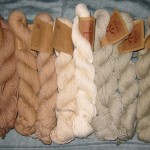 Fashion can be fun, but it also produces huge volumes of waste. When last year’s big look becomes this year’s big yawn, we have to start asking questions about the life cycle of the clothing industry. What are the real costs of stores and closets filled with clothing that is cheap and destined for the landfill? According to the US Environmental Protection Agency, Americans each discard about 30 kg of ‘waste’ clothing and textiles each year, amounting to 4 per cent of municipal solid waste. It’s a fair guess that the numbers for Canada are comparable.
Fashion can be fun, but it also produces huge volumes of waste. When last year’s big look becomes this year’s big yawn, we have to start asking questions about the life cycle of the clothing industry. What are the real costs of stores and closets filled with clothing that is cheap and destined for the landfill? According to the US Environmental Protection Agency, Americans each discard about 30 kg of ‘waste’ clothing and textiles each year, amounting to 4 per cent of municipal solid waste. It’s a fair guess that the numbers for Canada are comparable.
Chemical Concerns
Apart from waste, there are concerns about how fabrics used in clothing and textiles are produced and what chemicals are used to dye and treat them. For example, Health Canada has acknowledged concerns about polybrominated diphenyl ether, a flame retardant used in plastics and upholstered furniture (but not clothing). The production of “cheap” clothing and footwear has environmental, economic and labour implications for workers and consumers around the world. But there is good news, too. Sale of used clothing through thrift and consignment stores has increased substantially in recent years. And some recovered fabrics can be recycled into insulation, paper products and industrial rags.
Considerations
- Conventional cotton is the most highly treated agricultural crop. Nearly one-quarter of all pesticides used in the United States are dumped on cotton plants – thousands of tonnes every year. An increasing amount of cotton production is organic.
- Some cotton has been genetically engineered to tolerate high levels of herbicides.
- Clothing can be made from hemp, bamboo and other natural fibres whose production does not involve such heavy pesticide use.
- Concerns have been raised about health risks associated with the conventional dry cleaning fluid tetrachloroethylene, and alternatives substances are being sought.
- Some of the chemical compounds associated with the distinctive smell of new vinyl shower curtains are harmful to health, according to a report from Environmental Defence Canada. One study found dozens of toxic chemicals were released from vinyl shower curtains. Living Green, Living Well recommends the use of alternative materials such as hemp or cotton canvas. Even polyester (which is also a form of plastic) appears to be a safer material.
Suggestions
- Re-use! You can get great deals on clothing for the whole family at thrift stores and consignment shops.
- If cotton is your fabric of choice, choose organic cotton.
- Eco-stores may have clothing made from recycled plastic pop bottles.
- Look for Fair Trade labels on clothing and footwear.
- Choose well-made garments and mend them when necessary.
- Wash at lower temperature with gentle laundry cleaners to extend fabric life.
- Donate items to thrift stores and press for fabric recycling of worn-out materials.
- If other options are not available, items made from natural-source fabrics can be composted!
Check Out
- Organic Consumers Association Clothes for a Change Campaign



Recent Comments